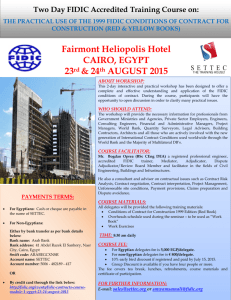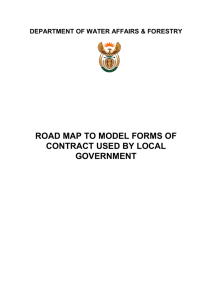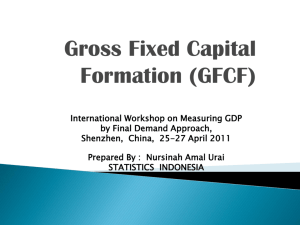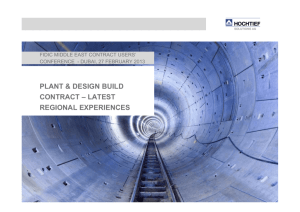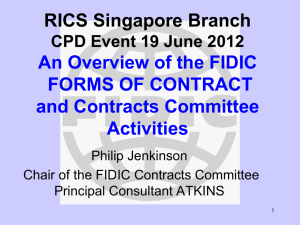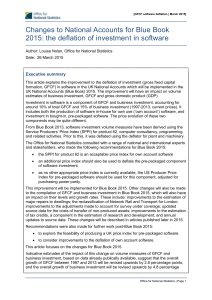New developments in best practice for plant and design
advertisement
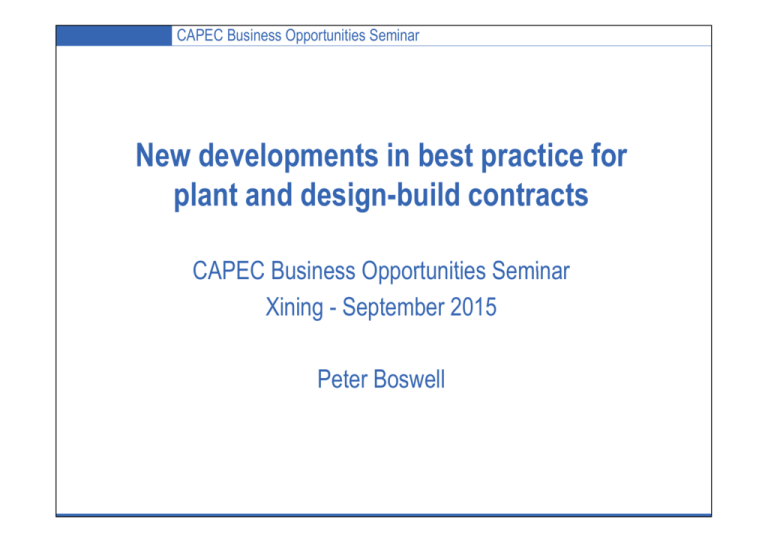
CAPEC Business Opportunities Seminar New developments N d l t in i best b t practice ti for f plant and design-build p g contracts CAPEC Business Opportunities Seminar Xining - September 2015 Peter Boswell Plant contracts – huge, growing demand Offshore Off h wind i d ffarms 22 of the world’s 25 largest operational wind parks in Europe. London Array: world’s largest off-shore wind farm (Phase 1 construction: €2.6 billion):) 175 wind turbines over 100 km2; 3 substations; 450 km of off-shore cables. Contracts: - foundations: construction installation - wind turbines: construction installation - off-shore substations: construction installation - cables: installation export cable production array cable production - vessels: supply Outline O tli Outline What is plant? p Need to quantify plant Plant investment (GFCF) ( ) GFCF category > GHG emissions Net Energy Analysis > GFCF category Plant procurement Plant contracts New Engineering Contract - FIDIC Plant Contract FIDIC Plant Contract: general developments Renewable energy sector The new normal Standard forms of contract What is plan? What is plant? “the apparatus, pp machineryy and vehicles intended to form or formingg ppart of the Permanent Works”. Plant = 50% cost? Wind farms (87% plant) Hydro: dam + powerhouse (multicontracts?) Need to quantify plant Need to quantify plant - Appropriate pp p regulations g - Procurement strategies - Contract provisions p ...... and climate change Plant GFCF Plant investment (GFCF) Impossible p to surveyy individual pplants. Need an overall approach: - National Accounts (GDP) gives balances between all parts of the economy. - Gross Fixed Capital Formation (GFCF) is part of GDP. - GFCF = net investment: that part of economic output which is building everything else. GFCF breakdown GFCF breakdown GFCF > Emissions GFCF category > GHG emissions Power and industryy GHG emission sector (electricity & heat production, manufacturing industry, construction, industrial processes) p ) = Other machinery and equipment GFCF category (machinery & equipment that generate & use electricity) No correlation! OECD 2012 Net Energy Analysis Net Energy Analysis National Accounts = jjobs, energy gy and economic volume flows throughout the economy. UK NEA Net Energy Analysis Test: models UK GFCF UK energy policy GFCF Equipment GFCF investment Onshore wind power Offshore wind power PV Solar hot water Cars better -30% energy PHEV (plug-in hybrid electric vehicles) LCVs (light commercial vans -38% energy HGVs (trucks) (tr cks) -44% 44% energ energy Aviation, improved efficiency Aviation, new aircraft Construction New low-energy dwellings Commercial buildings & factories,, renovation Dwellings, renovation Dwellings wall insulation Dwellings, Amount +50%; +300%; +75% +1200% 50% new use 7% new 80% new 50% new -15% energy use -21% energy use 50% new build 7% properties/y 2.5% properties/y 2 4% properties 2.4% per year UK energy policy - NEA Energy sector investments emissions The same can be done for all plant sectors to quantify plant! Plant procurement Plant procurement Type Traditional design-bid-build D i Design E l Employer Construction Contractor Contract Construction Plant Design-Build Contractor C t t D B team D-B t Contractor D-B team Plant & Design- Build Turnkey Contractor C t t Contractor Turnkey Plant procurement Employer’s risk Target price M lticontract Multicontract Split turnkey Contractor’s incentive Contracttor’s rissk C Employer’s flexibility Costreinbursable Plant contracts Plant versus Design-Build focus A pplant contract that allows for design-build g involves: - design-build delivery issues; - complexities p from the manufacture, installation, testing, g and commissioning of much technically sophisticated equipment Design-build Design build aspects given little attention since widely used and much knowledge has been developed: US 2014 US, US, 2010 bbuildings ildi - non-residential: 49% DB 50%DBB - industrial: i d ti l 36% DB ? public water & waste water: 57% DB ? Plant contracts Body AIA AGC CIOB DBIA EJCDC ENAA*** FIDIC*** ICC ICE IChemE Contract A141 Standard Form of Agreement Between Owner and Design-Builder Complex Projects Contract Document No. 525 - Standard Form of Agreement Between Owner & Design-Builder - Lump Sum C-700 C 700, General Conditions Model Form for Process Plant Construction Plant and Design-Build Contract pp y of an Industrial Model Contract for the Turnkeyy Supply Plant New Engineering Contract Contract for Lump Sum Contracts (Red Book) IET/IMechE MF/1: Model Form of Contract for design, supply & installation of electrical, electronic & mechanical plant. IMCA Marine Construction Contract JCT Major Project Construction Contract LOGIC Construction Contract (Edition 2) Orgalime Turnkey Contract for Industrial Works NT Int Date Use Not special p x - 2014 Buildings x x x x - Moderately complex plant 2013 Buildings with complex systems Moderately complex plant x x - x x x 2013 Not for plant plant. 2010 Process plant; power plant 2009 Moderately complex plant 2010 x x x x x x Minor plant items x 2013 Complex systems-based plant; process plant x 2010 Complicated wiring elements x x x - x x x x - 2012 Marine construction 2011 Large scale civil works Oil and gas; offshore wind energy 2003 Any process or industrial plant * Used by multinational or national development banks x x x x x - x x New Engineering Contract NEC3 (for civil engineering works +/- ‘minor plant items’) Format - not traditional ((for project p j managers): g ) - part skeleton contract, part management tool; - assembled to suit a specific p pproject; j - ‘black book’ front-end core clauses + ‘rainbow’ of contract provisions Focus - project management: - high engagement of the employer; - detailed management procedures and responsibilities; - regularly updated programme is standard. Contract conditions - flexible: - can structure clauses in many ways; - handles many pricing arrangements as standard; - variations are compensation events based on forecast cost. New Engineering Contract FIDIC Plant (for supply & installation of plant & erection on site) Format - traditional ((for lenders):) - separate documents; - ppart of a harmonised ‘rainbow suite’; - General Conditions + Particular Conditions. Focus - balanced risk: - employer’s requirements vital; - contractor design; usually associated with a plant supplier; - responsibilities allocated; procedures for programme updating. Contract conditions - coherent: - 20 structured clauses; - limited number of pricing arrangements as standard; - variations’ cost and time extension claimed separately. FIDIC Plant Contract FIDIC Plant Contract - a dedicated contract Procuringg the supply pp y & installation of pplant follows the same procedure as for employer-designed construction works. Certain significant g differences owingg to different types yp of pprojects: j - plant is largely manufactured off-site at a factory; - contractor usuallyy associated with a manufacturer or supplier; - detailed design of the plant is the contractor’s responsibility; - design to fulfil performance specification; - engineer administers the contract, monitors manufacture and erection on site and certifies payment; - testing and commissioning are comprehensive; - payment is mainly on a schedule of payments based on predefined measurable milestones; generally lump-sum basis. FIDIC Plant Contract: general developments - 1 FIDIC Plant Contract: general developments - 1 p for 2016. FIDIC Rainbow suite updates New elements - formats and new features of MDB Construction Contract, Construction Subcontract and Design, g Build and Operate Contract. - 20 clause structure reordered and changed to 21 clauses with Clause 20 only for claims (both contractor’s and employer’s). Principles restated - fitness ess for o pu purpose pose - good faith - pproactive contract management g ((e.g., g , earlyy warning). g) FIDIC Plant Contract: general developments - 2 FIDIC Plant Contract: general developments - 2 q strengthened g Documentation requirements - Employer’s requirements - Contractor’s programme p g - Contractor’s contemporary records Management systems systems’ requirements strengthened - Quality/Environment Detailed drafting - Further conditions precedent to the Commencement Date. - Variation procedure after an Engineer Engineer’ss instruction instruction. - Withheld Interim Payment Certificates follow-up. - Extension of the Defects Notification Period following retesting retesting. - Contractor bound to remedy all defects. Renewable energy sector – the new normal? Renewable energy sector – the new normal? Today, y few single-source g offshore turnkeyy contractors ((too risky; y low margins) so multicontracts widespread. Project owner: - has manyy contractors to choose from for each scope p of work; - employs directly and separately the turbine supplier, civil and electrical contractors, typically y y on a target-cost g model; - apportions liability on a case-by-case basis; - is responsible for co-ordinating the separate packages; - overlays project-wide alliancing obligations. Disadvantages: - increased owner risks; - contractor interfacing difficult; - cannot recover the costs of delays. The new normal? The new normal? Probably “yes” Multicontract issues are new ggeneric Plant Contract issues: - new roles, e.g., Warranty Surveyor; - more interfaces between contractors; - more difficult quality control/testing/commissioning issues; - more complex safety issues, issues ee.g., g wave heights = force majeur; - more prescribed (nominated) specialist equipment; - more technology issues, e.g., intellectual property, interfaces; g , site conditions change g - more insurance and liabilityy issues,, e.g., continually, equipment deteriorates before completion; - more contract issues, e.g., how to define fairly Defects Notification Period, life expectancy, Time for Completion. Standard forms of contract Standard forms of contract Under law, standard forms must be continuallyy updated. p They offer many advantages, with few disadvantages: - reduce negotiation g and re-drafting; g - less misunderstanding and fewer disputes; - fair in terms of apportioningg risks, obligations g & responsibilities; - key to opening up projects to international participation; - facilitate training of project and administrative staff; - avoid need for intensive effort to interpret contract conditions; - uncertainties of meaning are likely to be ironed out, so more predictable outcomes; - promotes best-practice contract administration and project management; - reduced need for legal advice. Conclusion Develop standard forms of plant contracts While new developments p in today’s y pproject j deliveryy tend to arise in specific industry sectors, the accompanying issues are mainly new ggeneric issues that need to be taken upp byy standard forms. Continue to incorporate generic plant-related contract issues as opposed to sector-specific sector specific issues so that valuable features of standard forms are not lost, namely: - efficiency - transparency - facilitated ac a ed ddispute spu e resolution eso u o - and above all a coherent contractual framework for tacklingg climate change. g THANK YOU
